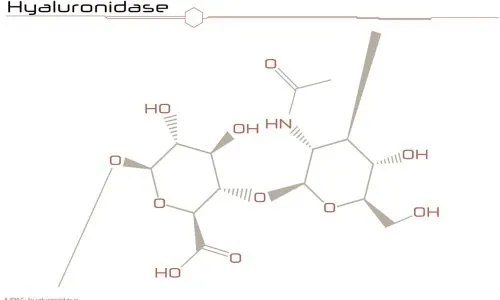
Hyaluronidase is an enzyme used to facilitate the uptake and absorption of other substances when injected into the body.
Primary uses of hyaluronidase injections include:
- Treatment of dehydration when used with other fluids
- Use with contrast dyes so parts of the body show up clearly on certain scans or x-rays
- To help improve absorption of radioactive substances during a procedure called subcutaneous urography
- To reverse the effects of dermal fillers upon client request
Hyaluronidase is either sourced from pigs or cows, and can also be produced in a laboratory when recreated from human albumin sources. Common brand names in the United States include Amphadase, Hydase, Hylenex, and Vitrase.
Hyaluronidase History
Several types of hyaluronidase were initially classified in 1971 by a German biochemist named Karl Meyer. Meyer grouped them into three distinct groups that include two classes of eukaryotic endoglycosidase hydrolases and a prokaryotic lyase-type of glycosidase.
Humans exhibit five functional hyaluronidases that include HYAL1, HYAL2, HYAL3, HYAL4, and HYAL5 (also known as PH-20 or SPAM1), in addition to a nonfunctional segment of DNA (or pseudogene) known as HYAL6 or HYALP1.
How Hyaluronidase Works
Hyaluronidase catalyzes the hydrolysis of hyaluronan. Hydrolysis is a process where a molecule of water breaks one or more chemical bonds. Hyaluronan is a part of the extracellular matrix that provides support to surrounding cells. The action by which this is accomplished is through the lowered viscosity of hyaluronan, which then increases the ability of substances to pass through tissue. By breaking through tissues, hyaluronidase allows drugs to be dispersed and delivered throughout the body.
Get your requested raw materials quotation
Role in pathogenesis
Hyaluronidase may be produced by some bacteria that include Streptococcus pyogenes, and Staphylococcus aureus, and Clostridium perfringens, as a way to use hyaluronan as a source of carbon. Hyaluronidases are also found in the venom of certain snakes, honeybees and lizards, where they enable spreading of the substance in a similar way to bacterial hyaluronidases.
Hyaluronidase Medical Uses
Hyaluronidase injections have several medical uses that include:
- Increased absorption rate of fluids given by injection (parenteral) or intravenously (hypodermoclysis)
- Improved resorption of radiopaque agents in subcutaneous urography (a radiological procedure used to visualize abnormalities of the urinary system)
- Extravasation of hyperosmolar solutions
- To reverse effects of hyaluronic acid injections when used as dermal fillers
- To counteract poisonous effects of vinca alkaloid overdose or extravasation
Hyaluronidase Contraindications
Some common hyaluronidase contraindications include:
- Allergies (determined by a medically supervised skin test)
- Medications that include furosemide (Lasix), phenytoin (Dilantin), diazepam, lorazepam, alprazolam, Valium, Xanax, Ativan, Tranxene, and others sedative or anxiety medications, aspirin or salicylates, cortisone or ACTH (Corticotropin), estrogens and antihistamine medications
Hyaluronidase Side effects
Hyaluronidase may cause some side effects that do not require immediate medical attention. These reactions may gradually disappear as the body adjusts following injection. They include:
- Bleeding
- Blistering
- Burning sensation
- Cold sensations
- Skin discoloration
- Hives
- Feelings of pressure
- Inflammation (hot sensations)
- Infection
- Skin conditions
- Itchy skin
- Lumps
- Rash/redness
- Numb feelings
- Pain/soreness/stinging
- Scars
- Swelling/tenderness/tingling sensation, ulceration, or warmth sensation at the injection site
A medical professional may help mediate or help reduce some of the side effects, and it is advised to consult with a health care professional if they continue.
Side effects of hyaluronidase that require immediate medical attention include:
- Cough
- Swallowing difficulty
- Dizziness
- Increased and/or rapid heartbeat
- Hives or welts on the face, eyelids, lips, tongue, throat, hands, legs, feet, or sex organs (hives, welts or itching)
- Skin redness or rash
- Itching
- Puffiness or swelling of the eyelids, eyes, face, lips, or tongue
- Chest tightness
- Weakness or fatigue
Symptoms of hyaluronidase overdose include:
- Blurry vision
- Body chills
- Confused thinking
- Faintness, dizziness, or lightheadedness when rising suddenly from a sitting or lying position
- Irregular, rapid or pounding heartbeat or pulse
- Nausea
- Vomiting
- Swelling
- Skin redness
- Increased skin warming
- Sweating
- Fatigue, tiredness or weakness
Hyaluronidase FAQ
Medica Pharma is a trusted provider of Hyaluronidase. We partner with GMP manufacturers worldwide to source and provide the highest quality chemical products on the market.
Hyaluronidases were initially classified in 1971 by a German biochemist named Karl Meyer. He grouped them into three distinct classifications that include a prokaryotic lyase-type of glycosidase and two classes of eukaryotic endoglycosidase hydrolases.
Hyaluronidase takes effect immediately after injection with a typical duration action of 24 to 48 hours. In the case of dermal filler reversal, it starts to work immediately to break down and soften the skin with effects that may continue for up to three days.
Hyaluronidase can be produced in a laboratory when recreated from human albumin sources or sourced from animals such as pigs or cows. There are four different purified hyaluronidases approved for use in the United States that include one recombinant type and three sourced from animals.
Hyaluronidase is used in conjunction with other medicines to increase uptake and absorption into the body. It is also used in dehydration treatment when combined with other fluids. Hyaluronidase also increases absorption of radioactive substances during subcutaneous urography, and its also used in tandem with contrast dyes during an x-ray procedure to highlight parts of the body.
Hyaluronidase is an enzyme used in medical procedures, primarily to increase the absorption of other substances in the body. It can be produced in a laboratory when recreated from human albumin sources, or sourced from cows and pigs.
Medica Pharma products are GMP-certified
Good Manufacturing Practices (GMPs) protect consumers through guidelines that ensure the safe manufacture of cosmetics, food, beverages, dietary supplements, medical equipment and pharmaceutical products. Manufacturers conforming to GMP guidelines must meet strict standards to ensure their products demonstrate high quality across batches.
All products sold by Medica Pharma are GMP-certified.




